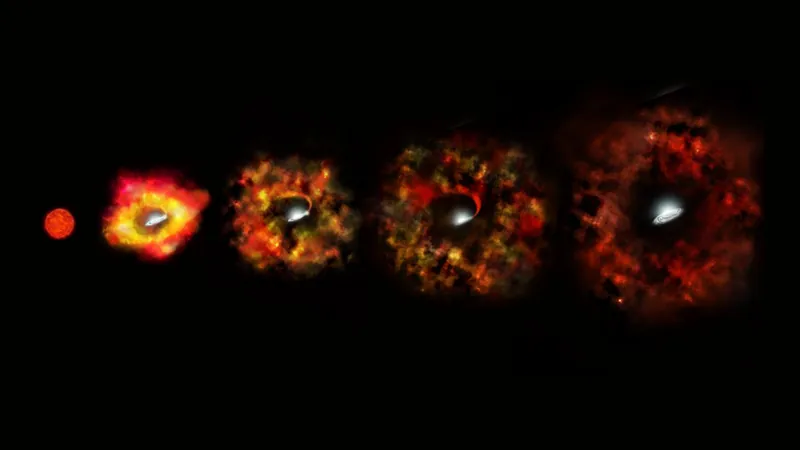
A Star's Mysterious Vanishing Act: The Birth of a Black Hole in Andromeda
2024-11-08
Author: Wei Ling
Introduction
In a stunning revelation that challenges everything we thought we knew about stellar deaths, astronomers have identified a massive star in the Andromeda Galaxy that didn’t go out with a bang, but rather vanished entirely, paving the way for the formation of a black hole. This remarkable find is pushing the boundaries of our understanding of supernovae and the lifecycle of massive stars.
Traditional Stellar Deaths
Traditionally, stars that are at least eight times more massive than our Sun meet their demise in an explosive event known as a supernova. These explosions can be so immense that they briefly outshine entire galaxies, leaving behind remnants that evolve into either black holes or neutron stars. Yet, this new research reveals a rare phenomenon where a star skips the fiery explosions entirely to collapse directly into a black hole.
The Case of M31-2014-DS1
The star in question, designated M31-2014-DS1, resided in the Andromeda Galaxy (M31). Discovered glowing in mid-infrared light in 2014, it showcased a curious pattern: for nearly three years, its brightness held steady before it dramatically faded from observations between 2016 and 2019. By 2023, it was completely undetectable in both optical and near-infrared surveys.
Research Insights
Led by Kishalay De, a postdoc at MIT’s Kavli Institute for Astrophysics and Space Research, the research team uncovered evidence that M31-2014-DS1 was born with a mass around 20 times that of our Sun but had shed significant material by the time it reached its final nuclear-burning phase. Surrounding the star was a dust shell—indicative of a supernova—but without any observed explosion, suggesting a dramatic yet silent demise.
Understanding the Phenomenon
“Such a profound and enduring decline in brightness is a rarity among massive stars,” the authors noted, revealing that M31-2014-DS1’s transition points to a stalled nuclear reaction, a process that could not generate the requisite energy for an explosive end. Essentially, the star collapsed under its own gravity, but without the explosive outburst typically associated with supernovae.
The Process Behind the Collapse
But what leads a star to miss the grand finale of a supernova? The answer lies within the physical processes at play. As a massive star reaches the end of its life, the core becomes increasingly dense, triggering a process called neutronization, where electrons combine with protons to form neutrons and neutrinos—a phenomenon capable of unleashing an incredible energy release typically heralding a supernova explosion.
Failure of Explosive Revival
In the case of M31-2014-DS1, the crucial neutrino shock necessary for revival and explosion failed to materialize, leading to the formation of a black hole with approximately 6.5 times the mass of our Sun. The researchers concluded that almost the entire mass of the star collapsed inward rather than erupting outwards.
Broader Implications
This event is not isolated; astronomers suspect that as many as 20% to 30% of massive stars may end their lives as failed supernovae. A similar case, N6946-BH1, was identified in 2009, showcasing the elusive nature of these "failed" supernova events, which often leave behind faint infrared traces instead of brilliant explosions.
Conclusion and Future Exploration
As we continue to probe the cosmos for clues, M31-2014-DS1 exemplifies the mysteries that lie within stellar evolution and the lifecycle of massive stars. This finding not only opens new avenues for research into black hole formation but also challenges longstanding theories surrounding stellar explosions, highlighting that the universe still has many secrets waiting to be unveiled. Keep your telescopes ready—more cosmic surprises may be just around the corner!



 Brasil (PT)
Brasil (PT)
 Canada (EN)
Canada (EN)
 Chile (ES)
Chile (ES)
 España (ES)
España (ES)
 France (FR)
France (FR)
 Hong Kong (EN)
Hong Kong (EN)
 Italia (IT)
Italia (IT)
 日本 (JA)
日本 (JA)
 Magyarország (HU)
Magyarország (HU)
 Norge (NO)
Norge (NO)
 Polska (PL)
Polska (PL)
 Schweiz (DE)
Schweiz (DE)
 Singapore (EN)
Singapore (EN)
 Sverige (SV)
Sverige (SV)
 Suomi (FI)
Suomi (FI)
 Türkiye (TR)
Türkiye (TR)